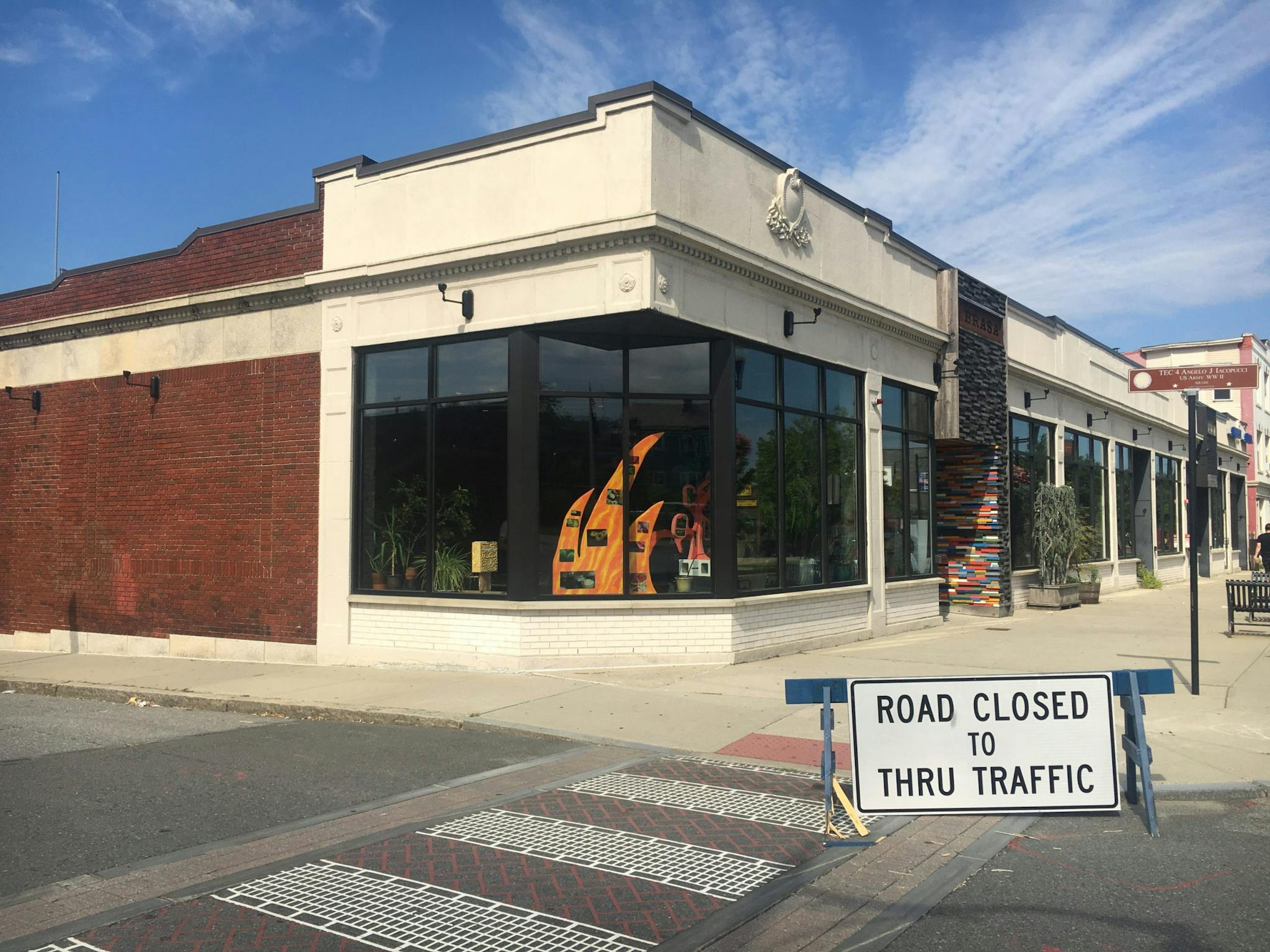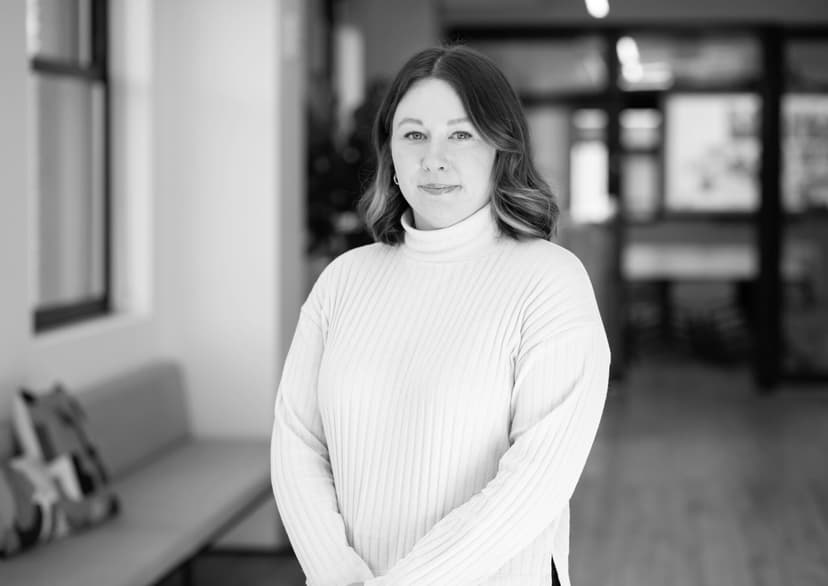What a difference a few months make. As the world seemingly shifted every day in March and April, art and cultural institutions scrambled to move their exhibitions and programming online. Now, almost six months later, AREA CODE Art Fair—the first art fair exclusively featuring artists with ties to New England—launched on August 1. An on-and-offline celebration of regional artists, it aims to bring art and community back to the Northeast throughout the entire month.
Conceived by David Guerra, an independent curator and founder of the South End’s A R E A Gallery, AREA CODE is a self-described “testing ground” centered around boosting and supporting the creative communities in New England, which suffered in the wake of COVID-19.
After putting out a call to artists across the region earlier this summer, AREA CODE took shape as a hybrid fair, offering many different modes of engagement. The online Main section features works for sale, allowing viewers to browse through a diverse roster of nearly 90 emerging and established local artists. Accompanying the Main Section, the fair also boasts a lineup of digital performances, virtual public programs, and three in-person components including site-specific installations, public art, and even a drive-in theater for video art.
From June right up until its opening on August 1, curators Jen Mergel, Ellen Tani, and Marla McLeod worked with the founders of Space Us, Ellen Shakespear, and Stephanie Lee, to create what Mergel calls “site-responsive” installations that recontextualize art in the city. The Storefront Project, curated by Mergel, will showcase artwork by 11 recent MFA graduates whose thesis exhibitions were upended by COVID-19 in the windows of small businesses around Greater Boston. The Special Projects section, curated by McLeod and Tani, will present a series of work by artists responding to the social and cultural issues of the present moment. Sites include a highway underpass, a beach, and a garage door, along with the more traditional building walls and windows.

Artist Jessica Lau’s Demeter’s Alter (2019) and Sleeping Zelos (2019) displayed in the windows of Gather Here in Inman Square. Image courtesy of Space Us.
While these two sections had different curatorial aims, the process itself was cohesive and fluid between the five team members. “All of us were engaged in the process of suggesting artists, holding each other accountable, and carrying out the ethos and values of the fair,” Tani explains.
The curators leaned on the expertise of Lee and Shakespear, who have brought artistic and cultural events to vacant and underutilized spaces around Greater Boston over their two years running Space Us.
“We knew that to situate the works on our tight timeline, we’d need agile and creative partners who were familiar with sites and stakeholders throughout Boston—that is Space Us in a nutshell,” Tani says, adding that the duo also helped navigate the bureaucratic world of acquiring permits.
With a wide-ranging inventory of small businesses eager to host the works, Lee and Shakespear conceived a walk that links neighborhoods around Boston through art in the public realm—a new layer of the urban experience aiming to “make a walk exciting,” as Lee puts it. “A big part of what we’re hoping for is interactivity through major parts of the streetscape. We want these [installations] to be parts of people’s daily routines,” she elaborates.
For the Storefront Project, the team points to Jessica Lau’s installation of Demeter’s Alter and Sleeping Zelos at Gather Here, a craft studio and store in Inman Square, as an example of the consonances between the window and the work within it.
Lau’s sculptural, mixed-media work, full of different textures from soft to bumpy to stringy, looks at home in a traditional gallery setting. In the context of Gather Here, however, Lau’s use of many textiles is accentuated. “I could tell from her installation aesthetic and the way that the piece isn’t just hanging but in dialogue with the wall and floor, that she would know how to use the [storefront] space,” Mergel says.
When it came to the Special Projects, the team looked for work that responds directly to the ongoing pandemic, racial and social justice, and other contemporary issues. They searched for art that not only drew attention but also challenged the way we use the built environment.
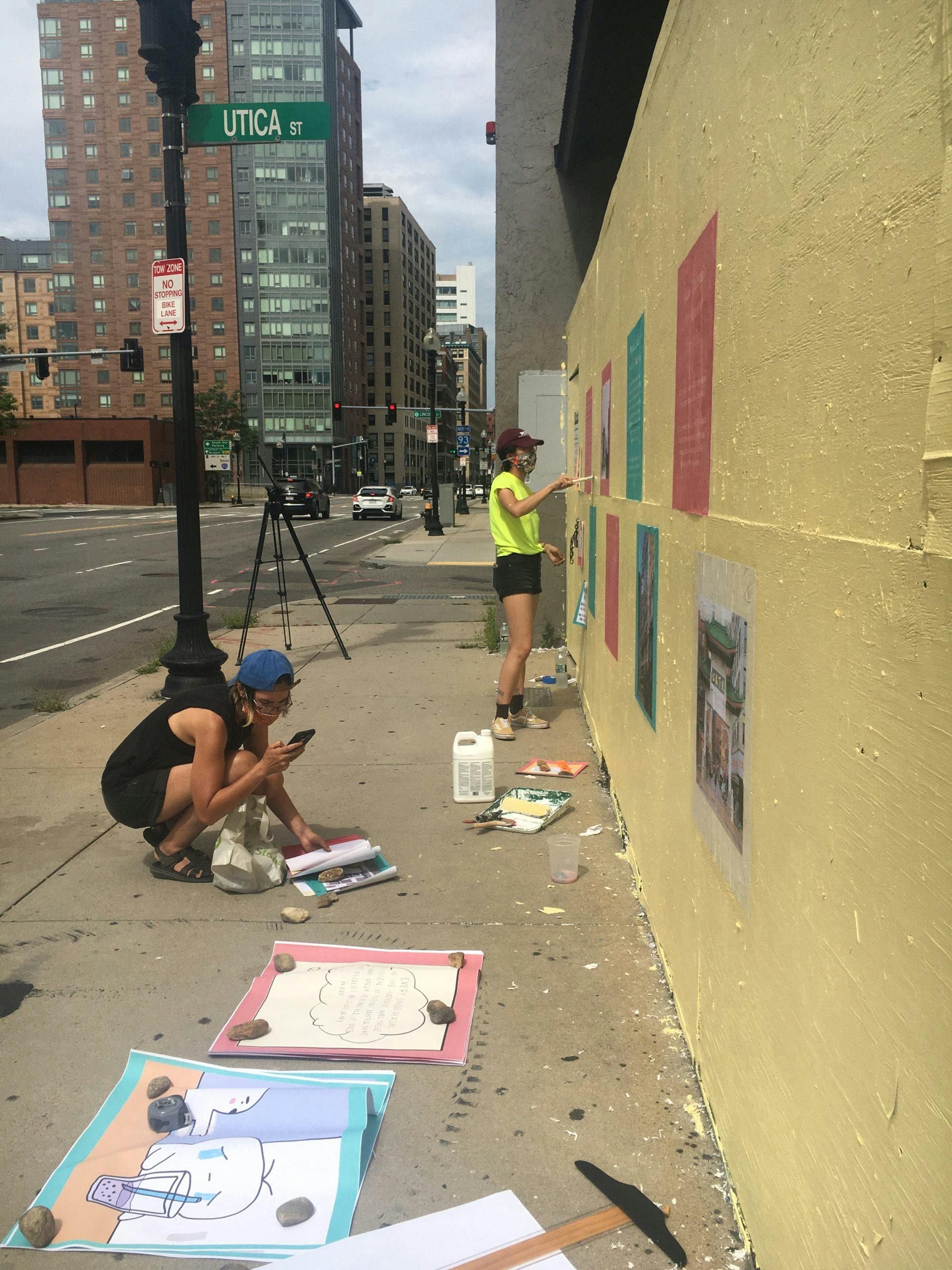
Artists Lily Xie and Crystal Bi Wegner installing Our Chinatown, wheatpaste mural at 150 Kneeland Street. Photo courtesy of Space Us.
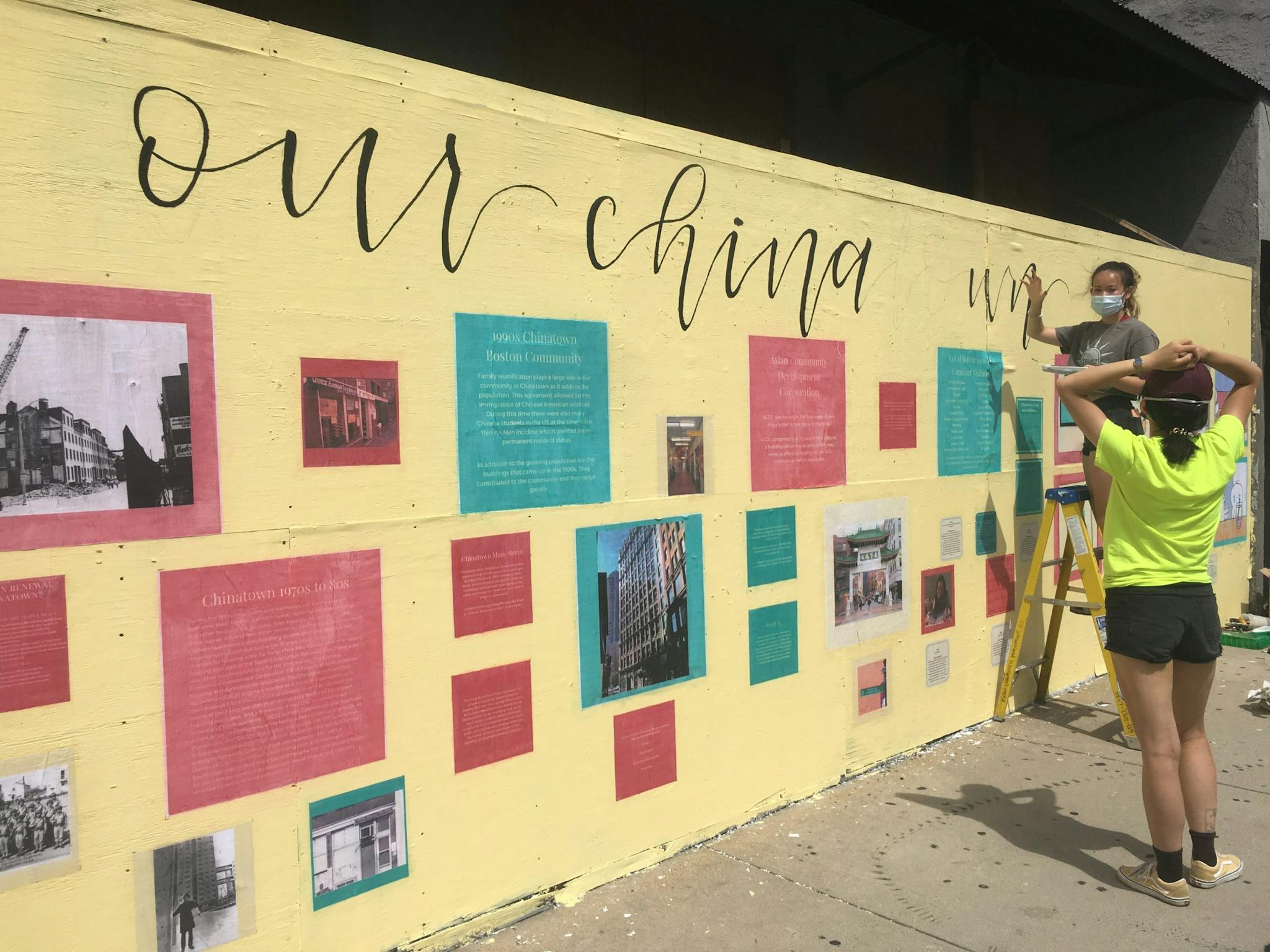
Artist Lily Xie and ACDC intern Wendy Zhu installing Our Chinatown, wheatpaste mural at 150 Kneeland Street. Photo by Crystal Bi Wegner.
A poignant example of this is Chinatown Story Cart, a project underway since before the pandemic by artists Lily Xie and Crystal Bi Wegner and created in partnership with the Asian Community Development Center (ACDC). The artists’ goal is to “foster deeper connections between residents and a more democratic imagining of the future of Chinatown” through the power of storytelling.
While Chinatown Story Cart takes many forms, for AREA CODE, Xie, Bi, and the ACDC created a mural with local youth at 150 Kneeland Street, a building in Chinatown intended for demolition. This new iteration of the project has been aptly titled, Our Chinatown and features a collage of historical photographs, original artwork, and text. Tani sees it as “a powerful gesture in the interest of cultivating community stewardship and negotiating the identity of a neighborhood that is under constant pressure to change.”
While Lau’s installation and the Our Chinatown mural are some of the first to be installed, work will continue to pop up around Boston throughout the entire month of August. Projects by Shaka Dendy and Tory Fair, as well as installations created in collaboration with protest photographers including OJ Slaughter and Harry Scales, will become both sought-out and serendipitous sites for reflection.
What results of this intimate collaboration between the curators and Space Us is the theme of unity in decentralization. Beyond just a result of the times we live in, it also ensures an even distribution of work throughout Boston. For those with the ability to walk or bike the route (which is yet to be completed), the distribution offers cadence and variety. One cannot help but feel a tinge of inspiration from land artists like Richard Long, who used walking as its own art form. In today’s context, these projects provide a reason to venture out and explore the city safely.
“We see it as a city-wide celebration of art that hopefully provides some healing for the whole city,” Shakespear remarks. Lee concurs, “We hope it creates a new sense of what it means to live in a city.”
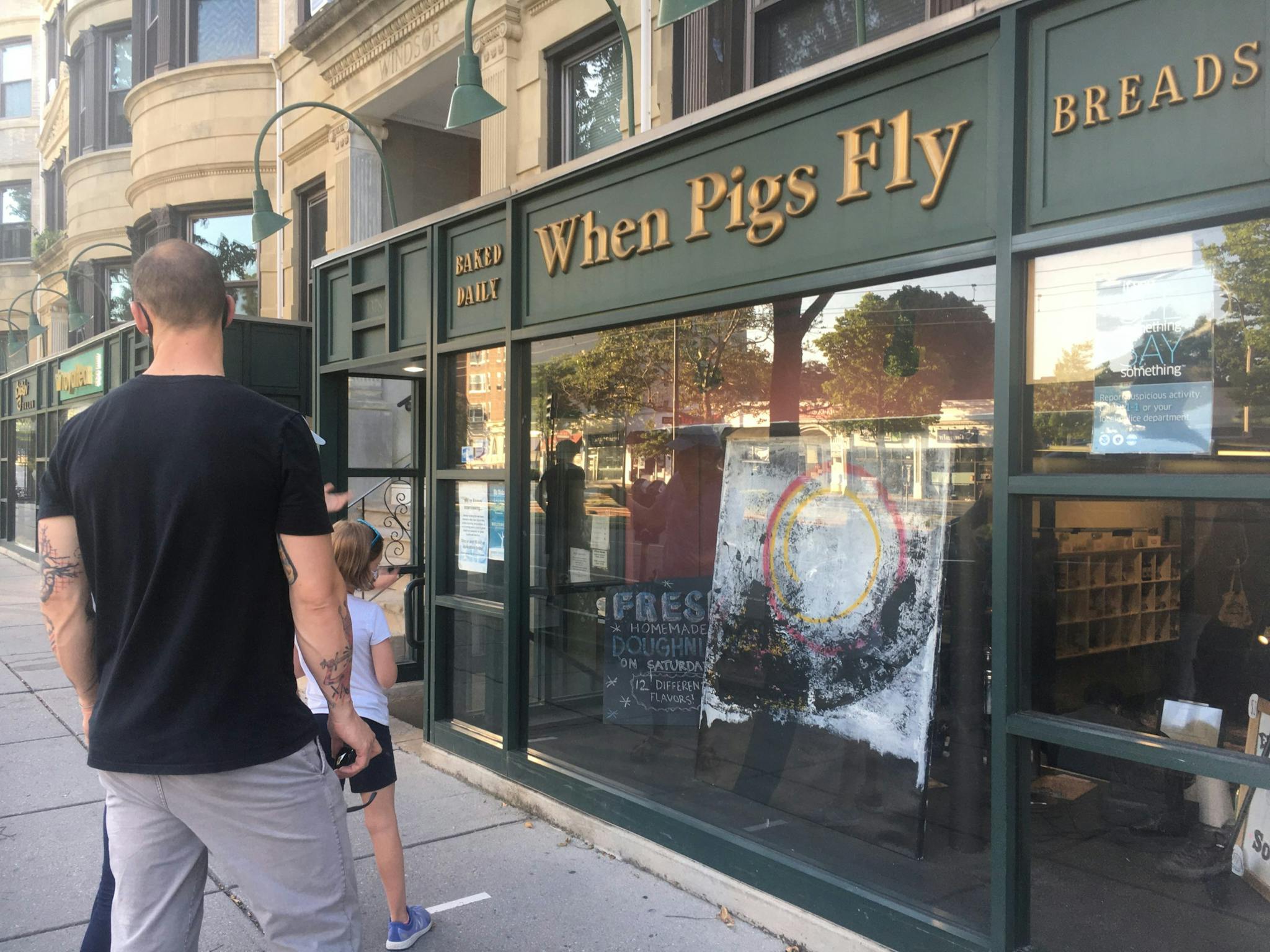
Artist Nathan Heilman in front of hafvilla : co p p er fl avor ed co ffe, 2020, installed at When Pigs Fly in Coolidge Corner.
With a unified vision, the team is excited to see the union of site and artwork transform the city. In talking about their goals for the work, Tani says, “I hope [our work] creates art lovers out of the people who pass by, if they weren’t already. I hope they bring joy, inspiration, and curiosity into peoples’ lives where they might not expect to find it. And I hope they encourage vulnerability and exploration at a time when those qualities have very different weight in our daily lives than they used to.”
While uncertainty still surrounds the reopening of many cultural institutions, the fair provides several avenues for engagement without the ticket price or ever stepping indoors. Through collaboration and exploration, AREA CODE’s swift response to city-wide closures is lowering the barrier to entry and inviting people to connect with the richness of creativity in New England through several online and offline platforms—a much needed relief to the digital landscape we’ve all come to inhabit.
__________________________________________________________________
AREA CODE Art Fair will run from August 1-31. Visit areacodeartfair.com for more information.
